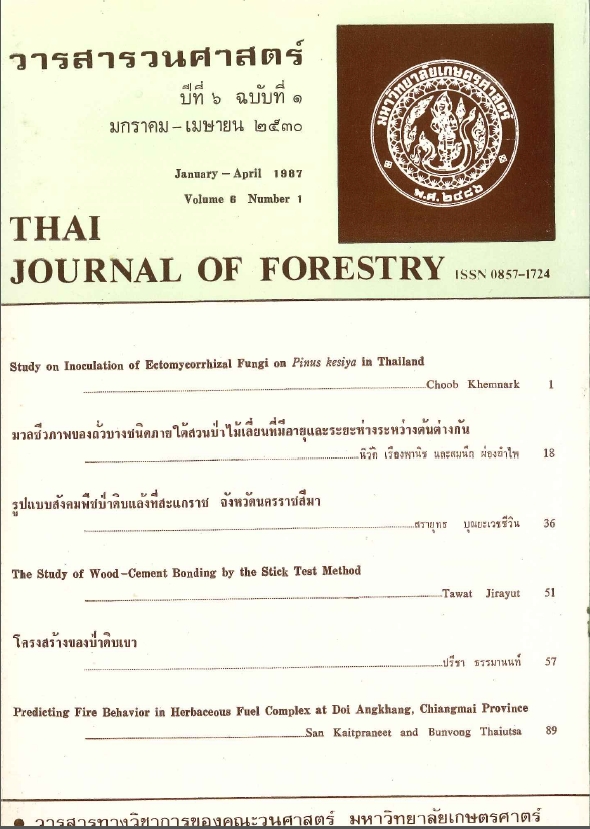รูปแบบสังคมพืชป่าดิบแล้ง ที่สะแกราช จังหวัดนครราชสีมา
Main Article Content
บทคัดย่อ
การวิเคราะห์ลักษณะทางนิเวศน์ของสังคมพืชป่าดิบแล้ง ที่สถานีวิจัยสิ่งแวดล้อมสะแกราช จ. นครราชสีมา ศึกษาโดยทำการเก็บข้อมูลจากแปลงตัวอย่างขนาด ๒๐ x ๕๐ ม. จำนวน ๒ แปลงต่อหมู่ไม้ จำนวน ๑๒ หมู่ไม้ จากการวิเคราะห์โดยวิธี cluster analysis สังคมพืชป่าดิบแล้งที่สะแกราชสามารถแบ่งออกได้เป็น ๒ สังคม คือ สังคมตะเคียนหิน (Hopea ferred type) และสังคมเคี่ยมคนอง (Shorea henryana type) สังคมตะเคียนหินมีพื้นที่หน้าตัดและความหนาแน่น (dbb ≥ 10 ซม.) มากกว่าสังคมเคี่ยมคนอง (๓๐ ม.๒ เฮกแตร์และ ๕๖๒ ต้น/เฮกแตร์ เปรียบเทียบกับ ๒๖.๔ ม.๒ เฮกแตร์และ ๕๑๔ ต้น/เฮกแตร์) ทั้งสังคมพืชป่าดิบแล้ง สังคมตะเคียนหิน และสังคมเคี่ยมคนอง มีรูปแบบการกระจายตามชั้นขนาดเส้นผ่าศูนย์กลางเป็นแบบ negative power curve ในขณะที่พันธุ์ไม้ในสังคมพืชที่มีรูปแบบการกระจายตามชั้นขนาดเส้นผ่าศูนย์กลางต่าง ๆ กันถึง ๕ รูปแบบ ความสัมพันธ์ระหว่างพื้นที่หน้าตัดของสังคมพืชป่าดิบแล้งกับปัจจัยแวดล้อม ปรากฏว่าแมกนีเซียม silt + clay pH ความลาดชัน ความชื้นในดิน ฟอสฟอรัส และความหนาแน่นรวม มีอิทธิพลต่อพื้นที่หน้าตัดของสังคมพืชป่าดิบแล้ง
Downloads
Article Details

อนุญาตภายใต้เงื่อนไข Creative Commons Attribution-NonCommercial-NoDerivatives 4.0 International License.
ข้าพเจ้าและผู้เขียนร่วม (ถ้ามี) ขอรับรองว่า ต้นฉบับที่เสนอมานี้ยังไม่เคยได้รับการตีพิมพ์และไม่ได้อยู่ในระหว่างกระบวนการพิจารณาตีพิมพ์ลงในวารสารหรือสิ่งตีพิมพ์อื่นใด ข้าพเจ้าและผู้เขียนร่วม (ถ้ามี) ยอมรับหลักเกณฑ์และเงื่อนไขการพิจารณาต้นฉบับ ทั้งยินยอมให้กองบรรณาธิการมีสิทธิ์พิจารณาและตรวจแก้ต้นฉบับได้ตามที่เห็นสมควร พร้อมนี้ขอมอบลิขสิทธิ์ผลงานที่ได้รับการตีพิมพ์ให้แก่วารสารวนศาสตร์ คณะวนศาสตร์ มหาวิทยาลัยเกษตรศาสตร์ กรณีมีการฟ้องร้องเรื่องการละเมิดลิขสิทธิ์เกี่ยวกับภาพ กราฟ ข้อความส่วนใดส่วนหนึ่ง หรือ ข้อคิดเห็นที่ปรากฏในผลงาน ให้เป็นความรับผิดชอบของข้าพเจ้าและผู้เขียนร่วม (ถ้ามี) แต่เพียงฝ่ายเดียว และหากข้าพเจ้าและผู้เขียนร่วม (ถ้ามี) ประสงค์ถอนบทความในระหว่างกระบวนการพิจารณาของทางวารสาร ข้าพเจ้าและผู้เขียนร่วม (ถ้ามี) ยินดีรับผิดชอบค่าใช้จ่ายทั้งหมดที่เกิดขึ้นในกระบวนการพิจารณาบทความนั้น”


